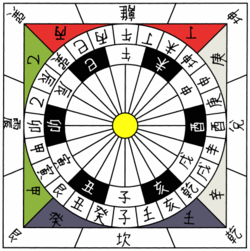- Earthly Branches
-
 A fountain in Almaty representing the 12 animals of the (Kazakh version of the) animal cycle
A fountain in Almaty representing the 12 animals of the (Kazakh version of the) animal cycle
The Earthly Branches (Chinese: 地支; pinyin: dìzhī; or Chinese: 十二支; pinyin: shí'èrzhī; literally "twelve branches"; or Korean:십이지) provide one Chinese system for reckoning time.
This system was built from observations of the orbit of Jupiter. Chinese astronomers divided the celestial circle into 12 sections to follow the orbit of 歳星 Suìxīng (Jupiter, the Year Star). Astronomers rounded the orbit of Suixing to 12 years (from 11.86). Suixing was associated with 攝提 Shètí (η Boötis) and sometimes called Sheti.
In correlative thinking, the twelve years of the Jupiter cycle also identify the twelve months of the year, twelve animals (mnemonics for the system), directions, seasons, months, and Chinese hour in the form of double-hours. When a Branch is used for a double hour, the listed periods are meant. When used for an exact time of a day, it is the center of the period. For instance, 午 (the Horse) means noon or a period from 11am to 1pm. (The jie qi system provided single hours and 15-degree arcs in time and space.)
Chinese seasons are based on observations of the sun and stars. Many Chinese calendrical systems have started the new year on the first new moon after the winter solstice.
The Earthly Branches are today used with the Heavenly Stems in the current version of the "traditional calendar" and in Taoism. The Ganzhi (Stem-Branch) combination is a fairly new way to mark time; in the Shang era it was the ten Heavenly Stems that provided the names of the days of the week. The Branches are as old as the Stems (and according to recent archaeology may actually be older), but the Stems were tied to the ritual calendars of Chinese kings. They were not part of the calendrical systems of the majority of Chinese.
Earthly
BranchMandarin
nameJapanese name Korean
nameVietnamese
nameChinese
zodiacDirection Season Lunar Month Double Hour On Kun 1 子 zǐ し(shi) ね(ne) 자 (ja) tý (Tí) Rat 0° (north) winter Month 11 11pm to 1am (midnight) 2 丑 chǒu ちゅう(chū) うし(ushi) 축 (chuk) sửu Ox 30° Month 12 1am to 3am 3 寅 yín いん(in) とら(tora) 인 (in) dần Tiger 60° spring Month 1 3am to 5am 4 卯 mǎo ぼう(bō) う(u) 묘 (myo) mão (mẹo) Rabbit 90° (east) Month 2 5am to 7am 5 辰 chén しん(shin) たつ(tatsu) 진 (jin) thìn Dragon 120° Month 3 7am to 9 am 6 巳 sì し(shi) み(mi) 사 (sa) tỵ Snake 150° summer Month 4 9am to 11am 7 午 wǔ ご(go) うま(uma) 오 (o) ngọ Horse 180° (south) Month 5 11am to 1pm (noon) 8 未 wèi び(bi) ひつじ(hitsuji) 미 (mi) mùi Goat 210° Month 6 1pm to 3pm 9 申 shēn しん(shin) さる(saru) 신 (sin) thân Monkey 240° autumn Month 7 3pm to 5pm 10 酉 yǒu ゆう(yū) とり(tori) 유 (yu) dậu Rooster 270° (west) Month 8 5pm to 7pm 11 戌 xū じゅつ(jutsu) いぬ(inu) 술 (sul) tuất Dog 300° Month 9 7pm to 9pm 12 亥 hài がい(gai) い(i) 해 (hae) hợi Pig 330° winter Month 10 9pm to 11pm Some cultures assign different animals: Vietnam replaces the ox, rabbit, and sheep with the water buffalo, cat, and goat respectively; Japan replaces the pig with the wild boar; Tibet replaces the rat, ox, rabbit and rooster with the mouse, bull, hare and bird respectively. In the traditional Kazakh version of the 12-year animal cycle (Kazakh: мүшел, müşel), the dragon is substituted by a snail (Kazakh: ұлу, ulw), and the tiger appears as a leopard (Kazakh: барыс, barıs).[1]
Contents
Directions
Even though Chinese has words for the four cardinal directions - 北 (běi, north), 東/东 (dōng, east), 南 (nán, south), and 西 (xī, west) - Chinese mariners and astronomers/astrologers preferred using the twelve directions of the Earthly Branches, which is somewhat similar to the modern-day practice of English-speaking pilots using o'clock for directions. Since twelve points were not enough for sailing, twelve midpoints were added. Instead of combining two adjacent direction names, they assigned new names as follows:
- For the four diagonal directions, appropriate trigram names of I Ching were used.
- For the rest, the Heavenly Stems were used. According to the Five Elements theory, east is assigned to wood, and the Stems of wood are 甲 (jiǎ) and 乙 (yǐ). Thus they were assigned clockwise to the two adjacent points of the east.
Following is a table of the 24 directions:
Character Mandarin name Japanese name Direction 1 子 zǐ ne 0° (north) 2 癸 guǐ mizunoto 15° 3 丑 chǒu ushi 30° 4 艮 gèn ushitora 45° (northeast) 5 寅 yín tora 60° 6 甲 jiǎ kinoe 75° 7 卯 mǎo u 90° (east) 8 乙 yǐ kinoto 105° 9 辰 chén tatsu 120° 10 巽 xùn tatsumi 135° (southeast) 11 巳 sì mi 150° 12 丙 bǐng hinoe 165° 13 午 wǔ uma 180° (south) 14 丁 dīng hinoto 195° 15 未 wèi hitsuji 210° 16 坤 kūn hitsujisaru 225° (southwest) 17 申 shēn saru 240° 18 庚 gēng kanoe 255° 19 酉 yǒu tori 270° (west) 20 辛 xīn kanoto 285° 21 戌 xū inu 300° 22 乾 qián inui 315° (northwest) 23 亥 hài i 330° 24 壬 rén mizunoe 345° Advanced mariners such as Zhèng Hé used 48-point compasses. An additional midpoint was called by a combination of its two closest basic directions, such as 丙午 (bǐngwǔ) for the direction of 172.5°, the midpoint between 丙 (bǐng), 165°, and 午 (wǔ), 180°.
See also
- Sexagesimal cycle (干支)
- Sheng Xiao
- Celestial stem
- Chinese calendar
 (A study of the cardinal directions chart)
(A study of the cardinal directions chart)
References
- ^ А. Мухамбетова (A. Mukhambetova), Казахский традиционный календарь The traditional Kazakh calendar (Russian)
External links
Jupiter Characteristics 
Moons Trojans Exploration Past and currentFuture- Europa Jupiter System Mission
- (Jupiter Europa Orbiter
- Jupiter Ganymede Orbiter)
- Europa (Colonization
- Terraforming)
Miscellaneous - Comet Shoemaker-Levy 9
- (2009 Impact)
- Jupiter-crossing minor planets
- Mythology
- In fiction (Jupiter
- Moons)
Categories:- Chinese calendars
- Technical factors of astrology
- Jupiter in mythology
Wikimedia Foundation. 2010.

